 |
Safely across the Caribbean
Snowy's third migration north is complete. After a very early start and a couple of long stopovers, she finished with a sprint up the east coast.
Snowy was tagged as a juvenile on Martha's Vineyard in the summer of 2011. Of the other 49 juveniles we've tagged, only Belle has survived longer.
Scroll down for all her maps since last spring.
or
Jump to the start of spring migration
|
 |
A quick spring trip - 2014 migration
That was easy! There's a lot to be said for wintering in Cuba. The trip home took only a week.
She only had to fly 1,696 miles (2,739 km) to get from Cuba to her natal area on Martha's Vineyard.
|
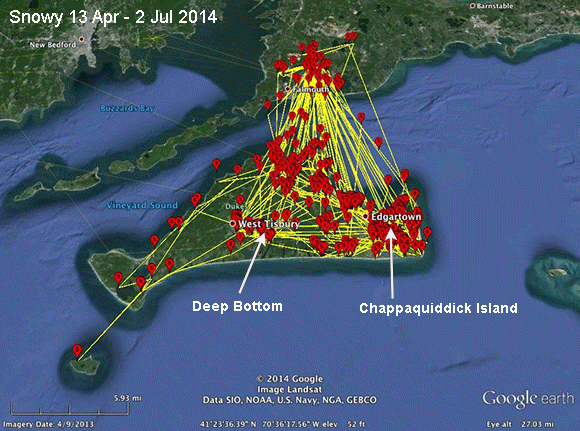 |
Commuting
Just like last year, Snowy spent a lot of time commuting between Cape Cod and the Vineyard. Snowy spent her Cape Cod time on John Parker Pond and Pond 14 (aka Dutchman’s Ditch), both ponds on the Coonamessett River where she fished during the herring run. After the herring run she started fishing in the ponds along with many other Osprey, a good place to find a mate. (Thanks to LInda Chambers for the update on Snowy's locations on the Cape.)
She was born on Snow Point on Chappaquiddick Island (hence her name).
Deep Bottom is an "all you can eat" herring smorgasbord in the spring.
During this time, she went back and forth between the Cape and Vineyard 35 times!
|
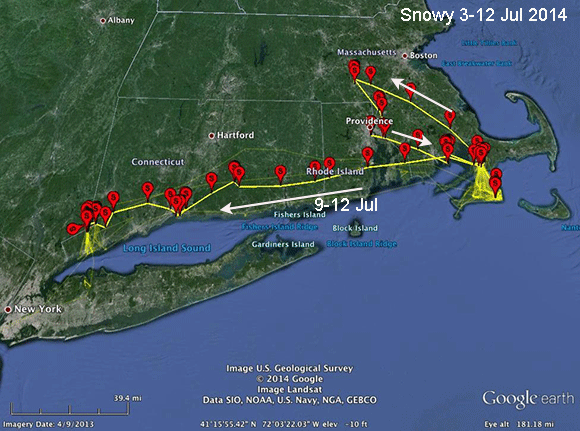 |
Road trips
Snowy's first trip away from the Cape and Vineyard area was a quick one (3-8 July). A day after returning, she flew to the Laurel and North Stamford Reservoirs in southwestern Connecticut, exactly as she did last summer.
|
 |
Long distance commuting
Ten days later, Snowy headed back to Martha's Vineyard, where she spent her last week of this summer there. On the 30th she was back on the wing, heading for her Connecticut fishing holes.
|
 |
Migration begins
After two weeks bopping around SW Connecticut, she crossed Long Island sound and spent three days prepping for migration. On the 18th, she was off for points south.
I fully expected her to just migrate back to Cuba, where she spent her second winter.
|
 |
17-25 Aug 2014
Snowy was the first to head south--just a day later than she left last year. We had been calling Snowy a male, but after another August departure (typical of adult females, not males) I had a look at the banding data and saw the weight was awfully high for a young male and fairly typical for a fledgling female, so Snowy's a "she." Glad we picked an sexually ambiguous name.
Snowy was a bird on a mission. She arrived back at her wintering area in northern Cuba just eight days after she left her staging area in Long Island.
|
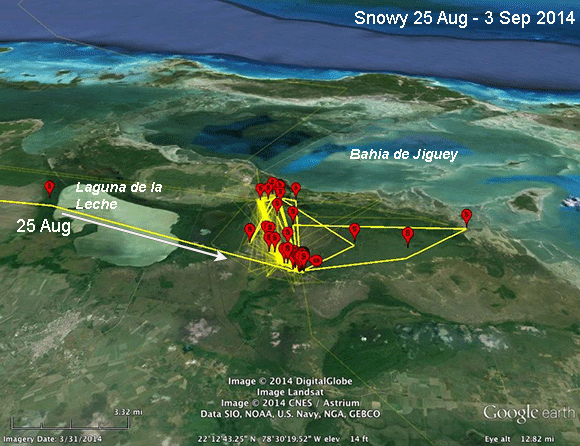 |
Settled down for the winter (?)
Snowy was right back between the Laguna de la Leche and the Bahia de Jiguey, where she spent a month on her first trip north in 2013 and all of the 2013-2014 winter.
|
 |
Last winter
Here are the locations for Snowy's last two months in Cuba in early 2014.
She liked this spot so much that on her way south in 2013, she had to backtrack to get to it, having overshot and finding herself southeast of this apparently rich fishing ground.
So of course she was going to stay here for another winter....
|
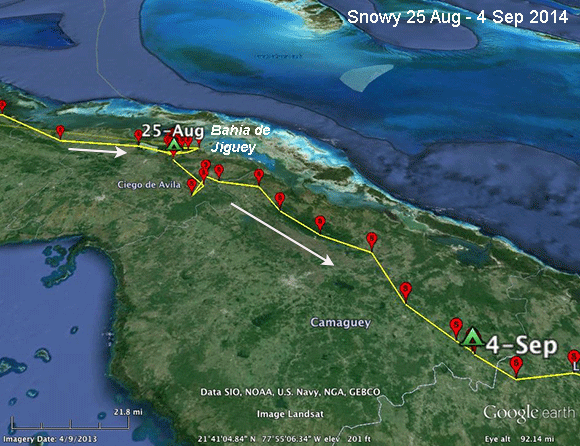 |
She did what?!
This was a big surprise. Why abandon this spot, which was obviously a great fishing area and relatively close to home?
It's easy to fall into the trap of rationalizing the decisions that animals make. This will simply remain a mystery. Could the number of fish available in such a large area have changed enough that she would be force to abandon the spot? If so, why not just move down the coast a few dozens of miles?
For whatever reason, that wasn't an option for her. If it were indeed a lack of fish, she apparently swithed to Plan B, which was to go to the other place where she knew there are a lot of fish, even if that meant flying an extra 1,700 miles (2,800 km) or so.
|
 |
Back in South America
Once she decided to abandon her spot in Cuba, it was business as usual for her. She hadn't been to Hispaniola or across the Caribbean since the spring of 2013, when she was returning home on her first migration north.
|
 |
Back in the llanos
Snowy followed a well traveled route around Lake Maracaibo, northeast along the eastern range of the Andes to a pass near Barquisimeto in the state of Lara.
Four days later she was in the llanos of Venezuela where she spent a week before flying back to her old fishing area around La Guarandinga in the state of Apure. We've had quite a few Ospreys winter in this area over the years.
Her migration this fall included 24 travel and 15 stopover days. Her roost-to-roost distance covered was 3,167 miles (5,097 km). Her full trip was 3,454 miles (5,558 km). She averaged 144 miles/day (231 kpd), which is very typical.
|
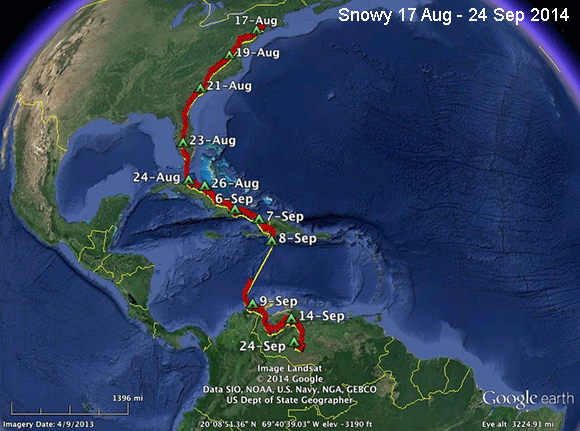 |
Fall migration complete
Here's the complete track for Snowy's 3rd migration south. See surprised us by not stopping in Cuba, but rather continuing back to Venezuela, where she spent her first 18 month stay in South America.
|
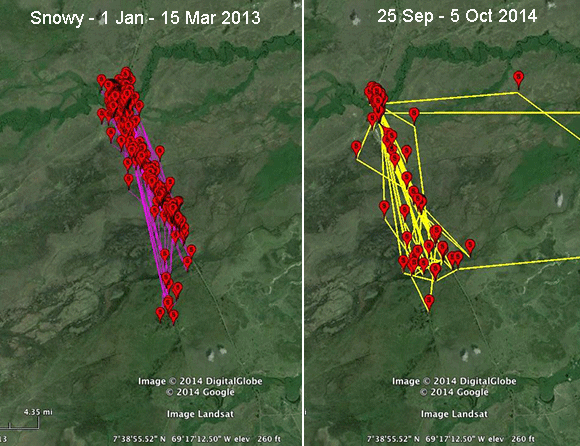 |
Back in groove
The map on the left shows all of Snowy's locations for the early winter of 2013, just before she headed north for her first migration. The map on the right shows the first 10 days of her stay this year in exactly the same place in the fall of 2013.
|
 |
An early start to spring migration
Snowy did a little test run on 18 February, moving north away from her regular wintering area for the first time all winter. She changed her mind and looped back home. Maybe she forgot something?
She got going again on the 20th. On the 21st she made it through a pass through the Andes and was heading for the Gulf of Venezuela.
|
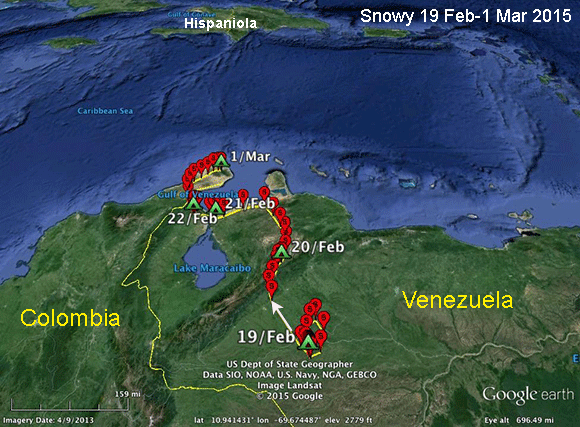 |
2015 spring migration continues
Snowy skirted the Gulf of Venezuela-Ospreys won't cross open water if they can get around it and will go to lengths to do so. She spent 6 days close to the shores of the Gulf before heading north on the 1st of March
She spent the night of the 1st on the Guajira Peninsula, a location very, very familiar to those who've been following these maps over the years. If one wanted to see a lot of Ospreys in the spring, this would be the place to go!
The next download should be on March 4th, when I suspect she will be on the other side of the Caribbean-maybe even in Cuba.
Will she stop at ther favorite fishing spot in Cuba this year on her way north, or will her hormones keep her moving?
Scroll down for all her maps since last spring.
|
 |
Safely across the Caribbean
The spring crossing of the Caribbean is always a lot safer than fall. We have never lost a bird crossing the Caribbean in the spring.
Snowy took off from the Guajira Peninsula just after 8 AM on the morning of the 2nd and just under 31 hours later was in Cuba. The trip was 607 miles (977 km). Her average speed was a slowish 19.6 mph (31.5 kph). Her average altitude over the water was 434 ft (135 m).
Once she got to Cuba she did not even perch to rest, but flew another 36 miles in just over 2 hours before finally settling down for perhaps a bit of fishing and a night's sleep. The next morning she made a bee line for her favorite fishing spot along Cuba's north shore, just east of Laguna de la Leche (Milk Lagoon).
This is where she spent a month on her way north way back in the spring of 2013 (her first trip north), spent the whole winter of 2013-14, and about a month on her way south in the fall of 2014.
We wonder how long she'll linger there this spring. With another storm hitting southern New England, she should stay put for a while!
|
 |
Back to a favorite spot
Snowy is back between the Laguna de Leche and the Bahia de Jiguey. She loves it here. The red track is her path in the fall of 2013, her second migration south. She spent the winter at the Laguna. The orange track is her third fall migration, in 2014. She stopped at the Laguna for a while, but then continued on, much to our surprise, and made it back to Venezuela, where she had spent her 1st 18 months south of the border.
Now she's back to fish some familiar fishing holes.
|
 |
Back home
After an extended (26 day) stop at her favorite spot in Cuba (where she spent all of the winter of her 2nd migration cycle), Snowy is back on Cape Cod and Martha's Vineyard.
Once she finally decided to head home, it was quick work--only 6 days from the middle of Cuba to Cape Cod. She had some wild tail winds on the 3rd, when she covered more than 400 miles, at least once hitting an amazing 50 mph.
|

